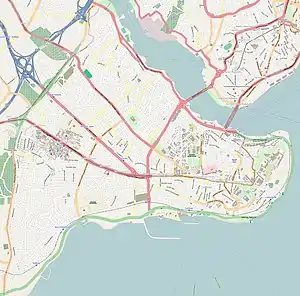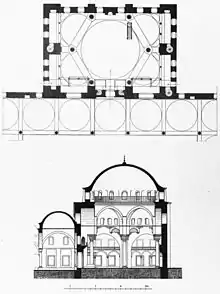| Kara Ahmed Pasha Mosque | |
|---|---|
 | |
| Religion | |
| Affiliation | Sunni Islam |
| Location | |
| Location | Istanbul, Turkey |
 Location within the Fatih district of Istanbul | |
| Geographic coordinates | 41°01′16″N 28°55′45″E / 41.02111°N 28.92917°E |
| Architecture | |
| Architect(s) | Mimar Sinan |
| Type | mosque |
| Style | Ottoman |
| Groundbreaking | 1555 |
| Completed | c. 1572 |
| Specifications | |
| Dome dia. (outer) | 12.0 m (39.4 ft) |
| Minaret(s) | 1 |
| Materials | ashlar masonry |

The Kara Ahmed Pasha Mosque or Gazi Ahmed Pasha Mosque (Turkish: Kara Ahmet Paşa Camii) is a 16th-century Ottoman mosque near the city walls in Istanbul, Turkey. It was designed by the imperial architect Mimar Sinan and completed in around 1572.
History
The mosque was commissioned by Kara Ahmed Pasha who was married to Fatma Sultan, a daughter of Selim I. He became grand vizier under Suleiman the Magnificent in 1553 but was executed by strangulation two years later in 1555. The mosque was planned in around 1555 but only constructed between 1565 and 1571–72 after the pasha had been fully exonerated.[1]
Architecture
The courtyard is surrounded by the cells of a medrese and a dershane, or main classroom. Attractive apple green and yellow tiles grace the porch, while blue and white ones are found on the east wall of the prayer hall. These tiles date from the mid 16th century. The 12 m (39 ft) diameter dome is supported by six red granite columns. Of the three galleries, the wooden ceiling under the west one is elaborately painted in red, blue, gold and black.[1] The mosque is last imperial building in Istanbul to be decorated with expressly designed cuerda seca tilework. Later buildings were decorated with tiles that were painted under a clear glaze.[2]
Gallery
 Gazi Ahmet Pasa Mosque courtyard with ablutions fountain
Gazi Ahmet Pasa Mosque courtyard with ablutions fountain Gazi Ahmet Pasa Mosque porch
Gazi Ahmet Pasa Mosque porch Gazi Ahmet Pasa Mosque Iznik tiles in porch
Gazi Ahmet Pasa Mosque Iznik tiles in porch Gazi Ahmet Pasa Mosque Iznik tiles in porch
Gazi Ahmet Pasa Mosque Iznik tiles in porch Gazi Ahmet Pasha Mosque şadirvan (ablutions fountain)
Gazi Ahmet Pasha Mosque şadirvan (ablutions fountain) Gazi Ahmet Pasha Mosque entrance from outside
Gazi Ahmet Pasha Mosque entrance from outside Gazi Ahmet Pasha Mosque entrance from inside
Gazi Ahmet Pasha Mosque entrance from inside Gazi Ahmet Pasha Mosque domes
Gazi Ahmet Pasha Mosque domes Gazi Ahmet Pasha Mosque mihrab
Gazi Ahmet Pasha Mosque mihrab Gazi Ahmet Pasha Mosque conch under half-dome
Gazi Ahmet Pasha Mosque conch under half-dome Gazi Ahmet Pasha Mosque conch
Gazi Ahmet Pasha Mosque conch Gazi Ahmet Pasha Mosque Iznik tiles with calligraphy
Gazi Ahmet Pasha Mosque Iznik tiles with calligraphy Gazi Ahmet Pasha Mosque Iznik tiles with calligraphy
Gazi Ahmet Pasha Mosque Iznik tiles with calligraphy Gazi Ahmet Pasa Mosque arabesques under western galleries
Gazi Ahmet Pasa Mosque arabesques under western galleries Gazi Ahmet Pasa Mosque arabesques under western galleries
Gazi Ahmet Pasa Mosque arabesques under western galleries Gazi Ahmet Pasha Mosque mausoleum founder
Gazi Ahmet Pasha Mosque mausoleum founder
See also
References
- 1 2 Necipoğlu 2005, pp. 377–384.
- ↑ Atasoy & Raby 1989, p. 220.
Sources
- Atasoy, Nurhan; Raby, Julian (1989). Iznik: The Pottery of Ottoman Turkey. London: Alexandra Press. ISBN 978-1-85669-054-6.
- Necipoğlu, Gülru (2005). The Age of Sinan: Architectural Culture in the Ottoman Empire. London: Reaktion Books. ISBN 978-1-86189-253-9.


